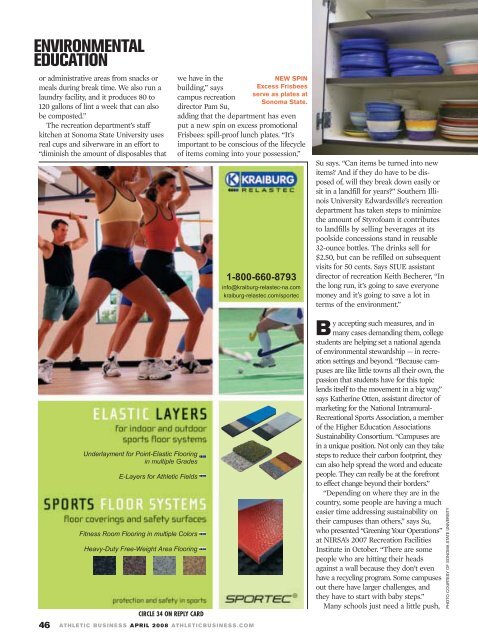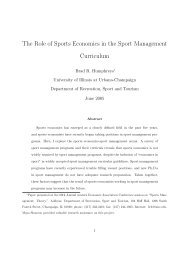Environmental Education
Environmental Education
Environmental Education
Create successful ePaper yourself
Turn your PDF publications into a flip-book with our unique Google optimized e-Paper software.
ENVIRONMENTAL<br />
EDUCATION<br />
or administrative areas from snacks or<br />
meals during break time. We also run a<br />
laundry facility, and it produces 80 to<br />
120 gallons of lint a week that can also<br />
be composted.”<br />
The recreation department’s staff<br />
kitchen at Sonoma State University uses<br />
real cups and silverware in an effort to<br />
“diminish the amount of disposables that<br />
Underlayment for Point-Elastic Flooring<br />
in multiple Grades<br />
E-Layers for Athletic Fields<br />
Fitness Room Flooring in multiple Colors<br />
Heavy-Duty Free-Weight Area Flooring<br />
CIRCLE 34 ON REPLY CARD<br />
we have in the<br />
NEW SPIN<br />
building,” says<br />
Excess Frisbees<br />
serve as plates at<br />
campus recreation<br />
Sonoma State.<br />
director Pam Su,<br />
adding that the department has even<br />
put a new spin on excess promotional<br />
Frisbees: spill-proof lunch plates. “It’s<br />
important to be conscious of the lifecycle<br />
of items coming into your possession,”<br />
46 ATHLETIC BUSINESS APRIL 2008 ATHLETICBUSINESS.COM<br />
1-800-660-8793<br />
info@kraiburg-relastec-na.com<br />
kraiburg-relastec.com/sportec<br />
Su says. “Can items be turned into new<br />
items? And if they do have to be disposed<br />
of, will they break down easily or<br />
sit in a landfill for years?” Southern Illinois<br />
University Edwardsville’s recreation<br />
department has taken steps to minimize<br />
the amount of Styrofoam it contributes<br />
to landfills by selling beverages at its<br />
poolside concessions stand in reusable<br />
32-ounce bottles. The drinks sell for<br />
$2.50, but can be refilled on subsequent<br />
visits for 50 cents. Says SIUE assistant<br />
director of recreation Keith Becherer, “In<br />
the long run, it’s going to save everyone<br />
money and it’s going to save a lot in<br />
terms of the environment.”<br />
By accepting such measures, and in<br />
many cases demanding them, college<br />
students are helping set a national agenda<br />
of environmental stewardship — in recreation<br />
settings and beyond. “Because campuses<br />
are like little towns all their own, the<br />
passion that students have for this topic<br />
lends itself to the movement in a big way,”<br />
says Katherine Otten, assistant director of<br />
marketing for the National Intramural-<br />
Recreational Sports Association, a member<br />
of the Higher <strong>Education</strong> Associations<br />
Sustainability Consortium. “Campuses are<br />
in a unique position. Not only can they take<br />
steps to reduce their carbon footprint, they<br />
can also help spread the word and educate<br />
people. They can really be at the forefront<br />
to effect change beyond their borders.”<br />
“Depending on where they are in the<br />
country, some people are having a much<br />
easier time addressing sustainability on<br />
their campuses than others,” says Su,<br />
who presented “Greening Your Operations”<br />
at NIRSA’s 2007 Recreation Facilities<br />
Institute in October. “There are some<br />
people who are hitting their heads<br />
against a wall because they don’t even<br />
have a recycling program. Some campuses<br />
out there have larger challenges, and<br />
they have to start with baby steps.”<br />
Many schools just need a little push,<br />
PHOTO COURTESY OF SONOMA STATE UNIVERSITY
















